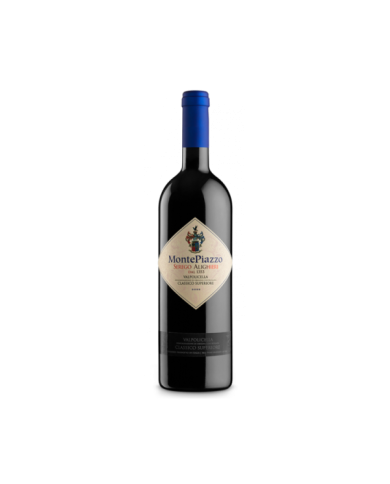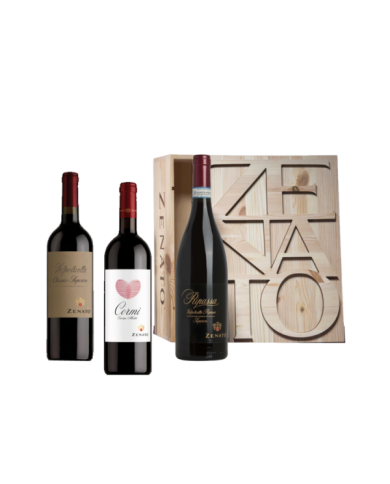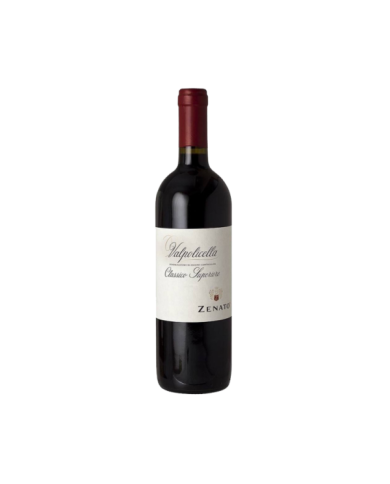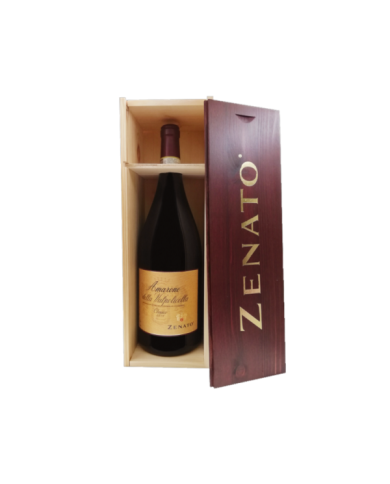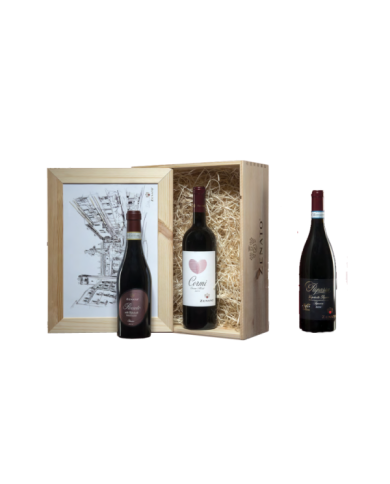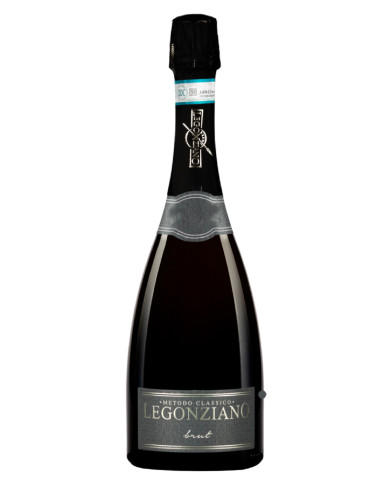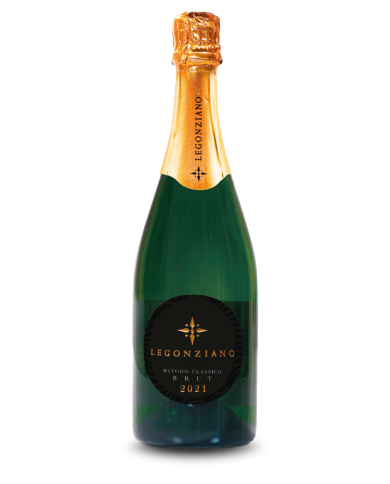It is an important Amarone, of extraordinary strength and complexity, a classic of Italian oenology. It represents the icon of the historic Serego Alighieri estates and comes from the vineyard of the same name from which the name Amarone seems to derive. The elegant personality is emphasized by the use of the Molinara clone Serego Alighieri and by the refinement in cherry wood barrels, as a family tradition.
Elegant, original wine with good structure and complexity. It is the archetype of Valpolicella described by Hemingway, " as cordial as the house of a brother you get along with ". The style of the noble Casato is emphasized by the use of the exclusive Molinara clone Serego Alighieri and by the refinement in cherry wood barrels.
The nobility of Amarone and Valpolicella Classico Superiore MONTEPIAZZO 2017 VAIO ARMARON 2013 natural wood box of 2 bottles
- _x0001_
- Valpolicella DOC Classico Superiore 2018 _x0001_
- Cormì Corvina Merlot Veneto IGT 2015 _x0001_
- Valpolicella Ripasso Superiore DOC Ripassa 2017
Zenato 's Ambrogio della Valpolicella is born in S. Ambrogio di Valpolicella, a hilly area on the Veronese shore of Lake Garda, within the "Classico" area of Valpolicella. It is in fact a real pleasure to give it and receive it: those who give it know they have purchased a great product and those who are passionate about wines know that when they receive an amarone, they can enjoy unique sensations.
Beautiful wooden box consisting of 3 bottles of wine:
- _x0001_
- Amarone della Valpolicella Classico 2016 _x0001_
- Valpolicella Superiore "Ripassa" - Zenato 2017 _x0001_
- Cresasso Veronese IGT 2015
Recioto Classico is a sweet red wine with intriguing and enveloping notes. After more than three months of drying, the grapes are left to ferment and then aged for 24 months in tonneaux, and then rest for another 12 months in the bottle. Aromatic range that alternates notes of cherry and figs with plums and cloves, soft and velvety sip, with a very generous persistence on the finish
Amarone della Valpolicella Classico dei Domìni Veneti is born in the historic area of Valpolicella Classica, from terraced vineyards interspersed with characteristic dry stone walls. Deeply concentrated garnet red. It is enhanced on the nose with hints of dried red fruit, tobacco and spices. The taste is surprisingly intense and decisive, with pure silk tannins. On the table it is perfect with braised meats and grilled meats, as well as with long-aged cheeses and game.
Appellation Valpolicella Classico: A Journey into the Heart of Italian Wines
The Valpolicella Classico Denomination represents excellence in the Italian wine scene. Located in the Veneto region of northeastern Italy, Valpolicella Classico is known for its high-quality wines, rich tradition and unique terroir. In this article, we'll explore the history, grape varieties, production process, and distinctive characteristics that make the Valpolicella Classico appellation so popular with wine lovers.
Introduction to the Valpolicella Classico Denomination
The Valpolicella Classico Denomination is one of the most prestigious sub-areas of Valpolicella, famous for the production of high quality wines. This denomination includes the oldest and most traditional hills of the region, which give the wines unique characteristics.
History and territory of Valpolicella Classico
The history of Valpolicella Classico has its roots in antiquity. The region has witnessed grape growing and wine production since Roman times. The Valpolicella Classico area is characterized by gentle hills and a soil composed of calcareous marl, gravel and clay. These geographical conditions give the wines a particular elegance and complexity.
Main grape varieties of Valpolicella Classico
The main grape varieties used in the production of Valpolicella Classico wines are Corvina Veronese, Corvinone and Rondinella. Corvina Veronese is the dominant vine and helps to give the wines structure, elegance and complex aromas. Corvinone is a vine similar to Corvina, but with a higher concentration of sugars. Rondinella, on the other hand, gives color and freshness to the wines.
Production process of Valpolicella Classico wines
The production of Valpolicella Classico wines follows a rigorous process that begins with the grape harvest, generally between September and October. After harvesting, the grapes are carefully selected to ensure the best quality.
The grapes are then gently pressed to extract the must, which is fermented at controlled temperatures. During fermentation, the must remains in contact with the skins for a specific period of time, allowing the transfer of aromas, colors and tannins.
Types of Valpolicella Classico wines
The Valpolicella Classico Denomination includes different types of wines, each with its own unique characteristics. Among the best known we find:
- Valpolicella Classico : a young and fruity red wine, with a fresh and lively taste.
- Valpolicella Classico Superiore: a more structured wine, obtained from selected grapes and a longer aging period.
- Valpolicella Classico Ripasso: a wine obtained from the fermentation of the base wine on the skins of Amarone, which gives greater structure and complexity.
Organoleptic characteristics of Valpolicella Classico wines
Valpolicella Classico wines are characterized by a wide range of aromas and flavours. They have notes of fresh red fruit, such as cherries and strawberries, with hints of spices and flowers. On the palate, they are balanced, with a pleasant acidity and soft tannins.
Culinary pairings with Valpolicella Classico wines
Valpolicella Classico wines lend themselves to versatile culinary combinations. They go well with light first courses, white meats, soft cheeses and cured meats. Valpolicella Classico Superiore and Valpolicella Classico Ripasso also go well with red meats, roasts and more mature cheeses.
Visit the Valpolicella Classico and its cellars
For wine lovers, a visit to the Valpolicella Classico cellars is an experience not to be missed. Numerous wineries offer guided tours, during which it is possible to get to know the wine production process closely, visit the vineyards and taste the fine Valpolicella Classico wines.
The Valpolicella Classico Denomination is a true jewel of the Italian wine scene. Its millenary history, the unique territory, the autochthonous vines and the high quality wines make this appellation particularly appreciated. If you are a wine lover, do not miss the opportunity to taste and discover the Valpolicella Classico wines, authentic ambassadors of Italian tradition and winemaking excellence.
FAQ (Frequently Asked Questions)
What is the origin of the Valpolicella Classico Denomination?
The Valpolicella Classico Denomination has ancient origins in the Veneto region of Italy. Its history dates back to Roman times.
What are the main grape varieties used in the production of Valpolicella Classico wines?
The main grape varieties used in the production of Valpolicella Classico wines are Corvina Veronese, Corvinone and Rondinella.
What are the best known types of Valpolicella Classico wines?
The best known types of Valpolicella Classico wines are Valpolicella Classico , Valpolicella Classico Superiore and Valpolicella Classico Ripasso.
What are the organoleptic characteristics of Valpolicella Classico wines?
Valpolicella Classico wines have notes of fresh red fruit, such as cherries and strawberries, with hints of spice. On the palate they are balanced, with a pleasant acidity and soft tannins.
What food pairings are recommended for Valpolicella Classico wines?
Valpolicella Classico wines go well with light first courses, white meats, soft cheeses and cured meats. The more structured versions are also suitable for red meats, roasts and more mature cheeses.
6. Is it possible to visit the Valpolicella Classico cellars?
Yes, many Valpolicella Classico wineries offer guided tours, during which it is possible to get to know the wine production process up close, visit the vineyards and taste the fine Valpolicella Classico wines.



